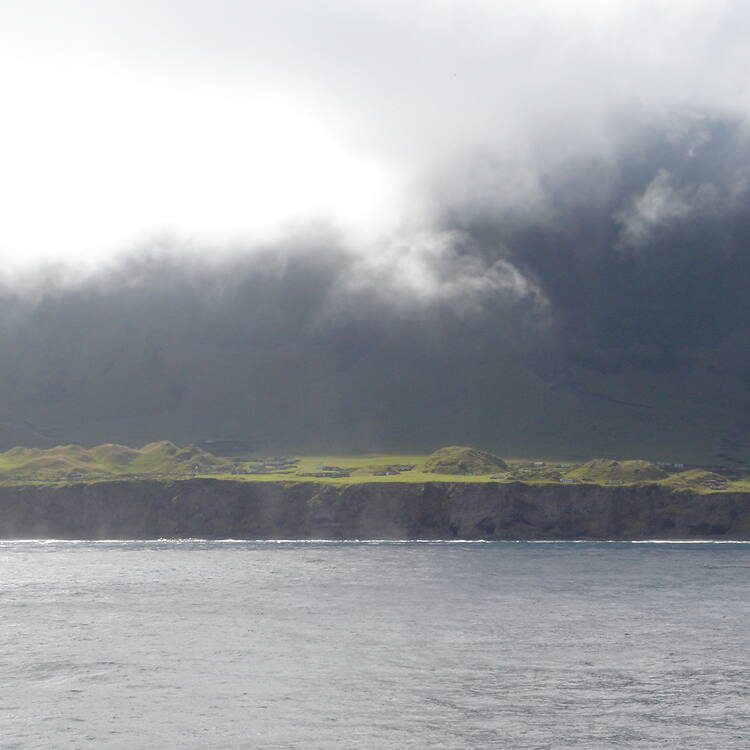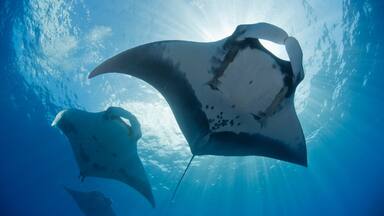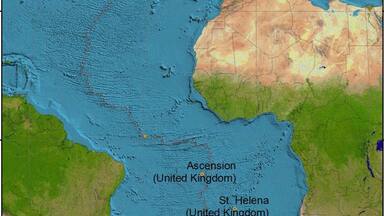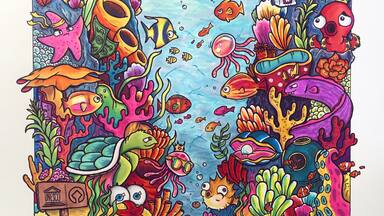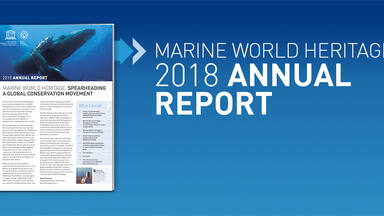Gough and Inaccessible Islands
Gough and Inaccessible Islands
The site, located in the south Atlantic, is one of the least-disrupted island and marine ecosystems in the cool temperate zone. The spectacular cliffs of Gough and Inaccessible Islands, towering above the ocean, are free of introduced mammals and home to one of the world’s largest colonies of sea birds. Gough Island is home to two endemic species of land birds, the gallinule and the Gough rowettie, as well as to 12 endemic species of plants, while Inaccessible Island boasts two birds, eight plants and at least 10 invertebrates endemic to the island.
Description is available under license CC-BY-SA IGO 3.0
Îles de Gough et Inaccessible
Les Îles Gough et Inaccessible représentent dans l’Atlantique sud un des écosystèmes insulaires tempérés froids les moins perturbés. Les deux îles, avec leurs falaises spectaculaires surplombant l’océan, ne comptent pas de mammifères introduits et abritent l’une des plus importantes colonies d’oiseaux marins au monde. L’île de Gough abrite deux espèces endémiques d’oiseaux terrestres, la gallinule de Gough et le rowettie de Gough, ainsi que 12 espèces de plantes endémiques. Pour sa part, l’île Inaccessible abrite 2 espèces d’oiseaux, 8 plantes et au moins 10 invertébrés endémiques.
Description is available under license CC-BY-SA IGO 3.0
جزيرتا غاف وايناكسيسيبل
تشكل جزيرتا غاف وايناكسيسيبل جنوب الأطلسي اثنتين من الجزر المعتدلة الباردة الأقل اضطراباً، فهما لا تأويان بشواطئهما الصخرية الرائعة المشرفة على المحيط أية ثدييات دخيلة بل إحدى أكبر جماعات الطيور البحرية في العالم. فجزيرة غاف تحتضن صنفين من الطيور الأرضية المستوطنة هما غالينول غاف ورويتي ، ناهيك عن 12 صنفاً من النباتات الاستيطانية. اما جزيرة ايناكسيسيبل فتحوي صنفين من الطيور وثمانية نباتات و10 لافقاريات استيطانية على الأقل.
source: UNESCO/CPE
Description is available under license CC-BY-SA IGO 3.0
戈夫岛和伊纳克塞瑟布尔岛
伊纳克塞瑟布尔岛位于南太平洋,面积14平方公里,是戈夫岛的扩展项目。戈夫岛于1995年被首次纳入《世界遗产名录》。该遗产现在称为戈夫岛和伊纳克塞瑟布尔岛,是该地区少有的几个未遭破坏保持完好的海洋生态系统的岛屿之一。每座岛上的悬崖景色壮观,俯瞰大海。岛上未曾引进哺乳动物,是世界上最大的海鸟栖息地。戈夫岛是两种当地稀有鸟类——秧鸡和罗维提鸟的栖息地,岛上还有12种当地特有植物。伊纳克塞瑟布尔岛拥有当地两种鸟类、8种植物和至少10种无脊椎动物。
source: UNESCO/CPE
Description is available under license CC-BY-SA IGO 3.0
Острова Гоф и Инаксессибл (Южная Атлантика)
Это одни из самых диких островов в пределах Южной Атлантики. На них не отмечено ни одного интродуцированного, чуждого местной природе, млекопитающего, а впечатляющие утесы, возвышающиеся над океаническими водами, дают приют одной из крупнейших в мире колоний морских птиц. На Гофе обнаружены два эндемичных вида птиц (местные разновидности овсянки и камышницы), а также 12 эндемичных видов растений. На острове Инаксессибл эндемичными признаны два вида птиц, восемь видов растений и, как минимум, 10 видов беспозвоночных животных. Остров Инаксессибл, площадью 14 кв. км, был в 2004 г. добавлен к объекту наследия, носившему с 1995 г. наименование «Резерват дикой природы на острове Гоф».
source: UNESCO/CPE
Description is available under license CC-BY-SA IGO 3.0
Islas Gough e Inaccesible
Situadas al sur del Atlántico, la isla de Gough y la isla Inaccesible figuran entre los ecosistemas insulares y marinos de la zona templada fría menos alterados por la presencia del ser humano. Ambas islas poseen imponentes acantilados que se yerguen como altas torres en medio del océano y albergan una de las colonias de pájaros marinos más importantes del planeta. Además, presentan la característica de que no se ha introducido ningún mamífero en ellas. La isla de Gough alberga doce especies endémicas de plantas y dos de aves terrestres: la gallereta y el semillero de Gough. Por su parte, la isla Inaccesible cuenta con dos especies endémicas de aves, ocho de plantas y diez de invertebrados como mínimo.
source: UNESCO/CPE
Description is available under license CC-BY-SA IGO 3.0
ゴフ島及びインアクセシブル島
source: NFUAJ
Eilanden Gough en Inaccessible
Source: unesco.nl
Outstanding Universal Value
Brief synthesis
Gough and Inaccessible Islands are two extraordinary uninhabited oceanic islands that have remained relatively undisturbed, and are therefore of special conservation significance. Gough Island is one of the largest cool-temperate oceanic islands in the world that remains close to pristine, having been spared most introductions of invasive species that have decimated unique island biodiversity elsewhere. While Inaccessible Island is smaller, it is of no lesser significance, housing a number of species endemic to this tiny speck in the South Atlantic Ocean.
The spectacular cliffs of each island, towering above the ocean, host some of the most important seabird colonies in the world. These include albatrosses, petrels, and penguins, reliant on the rich marine life surrounding them. Gough Island is home to two endemic species of land birds as well as twelve endemic plant species. Inaccessible Island also boasts three endemic subspecies and one endemic species of land bird – the Inaccessible Rail, which is the smallest flightless bird in the world –, and some eight endemic plant species. This island is also the only place where the Spectacled Petrel breeds, while the Atlantic Petrel and the Tristan Albatross are almost entirely restricted to breeding on Gough. The islands’ undisturbed nature makes them particularly valuable for biological research.
Criterion (vii): Two eroded remnants of long-extinct volcanos, Gough and Inaccessible Islands display outstanding natural beauty. Their precipitous cliffs around much of the coastline, covered with breeding seabirds, are highly spectacular.
Criterion (x): Gough and Inaccessible Island represent two of the least disturbed cool-temperate island ecosystems in the South Atlantic Ocean, and are internationally important for their colonies of some 22 species of seabirds, several of which only breed here. They also support a number of endemic species and subspecies of land birds, including the Gough Moorhen (a flightless rail) and the Gough Bunting, both endemic to Gough, and the Inaccessible Rail, the smallest flightless bird in the world, endemic to Inaccessible Island. This island forms part of the Tristan Endemic Bird Area, and Gough has been designated as its own Endemic Bird Area by BirdLife International. Key seabird species include the Atlantic Petrel, Spectacled Petrel, Tristan Albatross, Sooty Albatross, the subspecies of Yellow-nosed Albatross, and the Northern Rockhopper Penguin. The islands also support some 40 plant species (including vascular plants, bryophytes and lichens), which are endemic to the Tristan da Cunha island group, including a number of which are endemic to Gough and/or Inaccessible Islands.
Integrity
Gough and Inaccessible Islands are one of the most pristine environments left on earth. These remote South Atlantic islands, surrounded by protected marine areas of 12 nautical miles, are home to unique assemblages of plants and animals effectively isolated from the rest of the world by 2,000 nautical miles of open ocean and some of the world’s fiercest weather.
Inaccessible Island is one of the few oceanic islands with no introduced mammals, whereas Gough has introduced House Mice, significant predators of seabird chicks, and will, if uncontrolled, gradually reduce the biological value of the site. Sagina procumbens, an aggressive alien plant accidentally introduced during the 1990s, and a few other introduced plant species such as New Zealand Flax, could also degrade the integrity of the property if current control measures prove inadequate. However, the virtually undisturbed condition of Gough and Inaccessible Islands makes them particularly valuable for conservation and biological research. The islands are strictly managed as a Wildlife Reserve, IUCN Protected Area category 1, with research and weather monitoring the only activities permitted.
Protection and management requirements
Tristan da Cunha (including Gough and Inaccessible Islands) is a United Kingdom Overseas Territory forming part of the UK Overseas Territory of St Helena, Ascension, and Tristan da Cunha, and is administered by a UK-appointed representative, with support from an elected Island Council. The management authority is the Tristan Conservation Department, which employs permanent staff members supported by casual workers and the Tristan “Darwin team”. The Tristan da Cunha Environment Charter outlines the environmental management commitments of the UK Government and the Government of Tristan da Cunha, and serves as a framework policy to guide the development of management policies and plans.
The Conservation of Native Organisms and Natural Habitats (Tristan da Cunha) Ordinance 2006 gives statutory force to the general protection of the property, which is classified as a Nature Reserve. This provides strict protection to all native organisms and makes it an offence to transport any native organisms between islands or to introduce any non-native organisms. In parallel to this, the Tristan da Cunha Fisheries Limits Ordinance 1983 provides for the control of commercial fishing activity within the Tristan da Cunha exclusive economic zone, up to 200 nautical miles offshore from the islands.
The Gough and Inaccessible Islands World Heritage Site Management Plan focuses on identifying priority actions for the conservation of the property over a five year period, and does not supersede the two existing Management Plans for Gough and Inaccessible Islands. The Tristan da Cunha government has also developed a Biodiversity Action Plan that relates closely to the World Heritage Site Management Plan but covers the entire island group and its seas. A detailed operating/conduct code developed by the Tristan Government provides guidelines on best practice to be observed by visitors and managers of the two islands. Separate zoning strategies for Gough and Inaccessible Islands have been developed. On Gough, there are Logistic, Marine, Scientific research, and Conservation zones; on Inaccessible there are Accommodation, Natural, Wilderness, and Marine zones. Within these various areas, defined in detail in the respective Management Plans, certain activities are constrained or allowed. A single zoning strategy is needed covering the whole World Heritage property, including the marine area.
The UK is a State Party to the Ramsar and Bonn Conventions; the UN Convention on Biological Diversity; and the Agreement on the Conservation of Albatrosses and Petrels (ACAP).These conventions provide international obligations for the conservation of albatrosses and petrels, including the protection of important habitats and species. By agreement with the Tristan da Cunha government, these international conventions have been extended to cover Tristan da Cunha, and therefore the Tristan Government is obliged to fulfil their requirements locally.
In common with many island ecosystems around the world, alien invasive species are the most important immediate threat to the ecology of Gough and Inaccessible Islands. House Mice were introduced to Gough Island in the 19th century, and are known to have adverse impacts on both terrestrial and marine birds on Gough. In partnership with the Royal Society for the Protection of Birds, a mouse eradication programme as well as programmes to control or eliminate invasive plant species including Sagina procumbens and New Zealand Flax, are underway. Protocols are in place to ensure that no new introductions occur.
